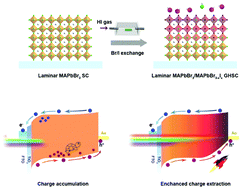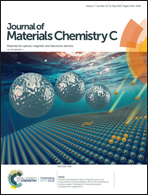A laminar MAPbBr3/MAPbBr3−xIx graded heterojunction single crystal for enhancing charge extraction and optoelectronic performance†
Abstract
Halide perovskite single crystals (SCs) have recently been regarded as a promising candidate in optoelectronic devices by virtue of their remarkable intrinsic properties. Herein, a laminar MAPbBr3/MAPbBr3−xIx (MA = CH3NH3+) graded heterojunction single crystal (GHSC) with a thickness of about 11 μm and an area of 4 × 5 mm has been synthesized via a space-limited inverse temperature crystallization growth method and a gaseous halide exchange process in sequence. Compared to the pristine MAPbBr3 SC, such a MAPbBr3/MAPbBr3−xIx GHSC possesses graded valence band alignment via a halide gradient distribution, which significantly enhances the hole extraction and accelerates carrier transport, leading to a high-performance perovskite SC photodetector with an improved external quantum efficiency of ≈170% at −2 V and an impressively rapid response speed of 0.56 μs. Our results provide a promising strategy to solve the carrier extraction obstacle and suppress recombination loss, which opens potential optoelectronic applications of laminar heterojunction SCs.



 Please wait while we load your content...
Please wait while we load your content...